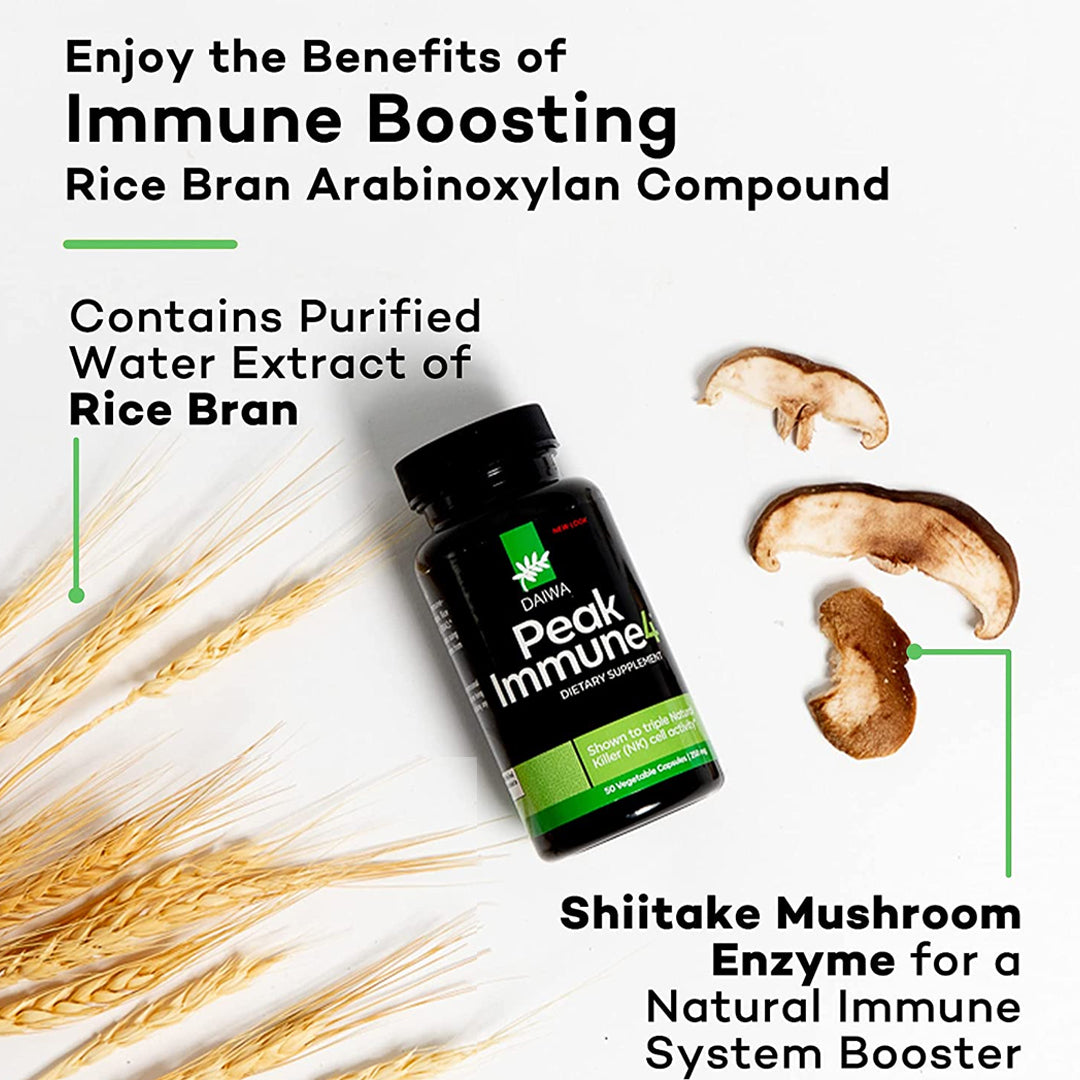Yet it’s the immune system and its interaction with the nutrient that’s at the heart of many of the benefits associated with vitamin D. But just what role does vitamin D play in supporting the immune system?
How the Immune System Regulates Your Overall Health

The job of the immune system is a fairly simple one: to protect the body from the risk of adverse health conditions caused by microorganisms and other foreign substances.
That’s a bit of an oversimplification. The immune system is actually regulated by a fairly complex series of interactions between proteins, nutrients and your body’s natural defenses. And susceptibility to outside pathogens, germs and bacteria is largely dependent on your immune system’s own innate vulnerability.
These outside pathogens contain their own proteins called antigens which trigger your immune system’s defense cells. If these antigens have never been encountered before, the result is typically a minor illness. At the same time, the immune system’s defense cells automatically register foreign antigens and can essentially “remember” them by developing antibodies for future contact.
When it functions correctly, the immune system is virtually unnoticeable. But when it becomes weakened, either due to a deficiency of nutrients or a particularly aggressive strain of microorganisms it hasn’t encountered before, the immune system’s natural line of cellular defense will be affected by everything from the common cold to potentially fatal diseases.
How Do Nutrients and Minerals Affect the Immune System?

The influence of nutrition on the immune system cannot be underestimated.
There are two chief subsets in our immune system: innate immunity and adaptive immunity. Innate immunity is a fairly generic form of immunity which responds to many pathogens in the same way—automatically. But it’s relatively limited in the scope of its response. Many strains of bacteria and other microorganisms alter their antigens to evade detection by innate immune response. And those strains are growing significantly[3] more diverse, with environmental factors and a weakening natural human immunity being just two factors in their prolonged survival.
Adaptive immunity, on the other hand, is responsible for generating those same antibodies which recall and combat foreign pathogens which previously bypassed the innate immune response. It’s a learned form of immunity, and one which is specific to particular strains of microorganisms, with killer T and B cells[4] being largely responsible for the development and modulation of antibodies.
And it’s adaptive immunity which can be increasingly affected by changes in nutritional intake.
Yet vitamins, minerals and nutrients help support and regulate both innate and adaptive immunity by protecting healthy cells, reducing oxidative damage and aiding in the production of antibodies. And there needs to be an optimal balance of both micro and macronutrients, proteins and essential minerals in order for the immune system to function properly. They are, quite literally, the building blocks of our immune responses, with undernutrition resulting in both limited T cell activity and the production of antibodies.
More than 2 billion people[5] are affected by vitamin deficiency across the globe, placing them at an increased risk[6] of cardiovascular disease, diabetes, hypertension, inflammatory disorders and osteoporosis. While many nutritionists have suggested dietary changes as a method of combating vitamin deficiencies resulting from undernutrition, there’s one essential mineral that’s rarely found[7] in many of the foods that we consume: vitamin D.
Why Vitamin D is Important For Optimal Health

Vitamin D is most often associated with bone integrity and calcium[8] absorption. But there’s a growing body of evidence that vitamin D can play a much more integral role in our overall health than ensuring healthy bones.
The role of vitamin D on the immune system is largely a regulatory one, with vitamin D receptors supporting the production and activity of T and B killer cells as well as antigen defense. But recent research suggests that an increased circulation of vitamin D may be associated with a decreased risk of both breast cancer[9] and colorectal cancer[10], as well as the prevention of cardiovascular disease and type 2 diabetes[11].
So why are these benefits frequently so sparse for Americans? The answer may be in our food supply.
The Inadequacy of Vitamin D Food Sources
There’s only a fairly limited number of food sources for vitamin D, particularly as the recommended daily allowance[12] for males and females is suggested to be 600 IU (or 15 micrograms.)It’s not uncommon for many manufacturers to fortify their foods with vitamin D in order to meet that recommended daily allowance. But the problem with fortified foods is that they are frequently highly refined and over processed[13] with additional preservatives including fats, sodium and sugars, which can not only complicate existing health conditions but create entirely new ones.
Some of the healthier choices of food sources for vitamin D include:
- Beef liver
- Egg yolk
- Fatty fish, such as salmon
- Milk
- Orange juice
- Sardines
- Swordfish
- Tuna fish
Vitamin D Deficiency and Supplementation
The primary source of vitamin D production is in the skin, particularly as a result of interaction with the sun’s UVB rays. But it’s been estimated that almost 42 percent[14] of the US population is deficient in vitamin D as a result of both limited sun exposure and the minimal presence of the vitamin in most foods. This has led to a surge of vitamin D supplement production, with some estimates indicating a market value of $1.23 Billion[15] in 2021.Some of the more common symptoms of vitamin D deficiency can include stress on the pelvis and hips, fatigue, mood changes and bone, muscle and joint pain. Yet those are minor compared to some of the risks associated with deficiency, including chronic kidney disease[16], cystic fibrosis[17], hypertension and cardiovascular disease and chronic liver disease—all of which can result from a severely compromised immune system.
Vitamin D alone may not be sufficient for many users looking to strengthen their immunity. While some manufacturers have begun to fortify their foods[18] with the nutrient, many foods don’t always meet recommended US dietary guidelines[19]. There is ongoing research[20] indicating that vitamin D in conjunction with other natural dietary supplements[21] may help optimize killer T and B cell activity in the immune system, however; particularly as a complementary form of conventional cancer treatments as well as glucose modulation[22] in diabetic patients.
Conclusion

We’re only now just finding out how significant a role vitamin D plays in helping to maintain our immunity. And as research continues into its benefits, that understanding is only likely to increase.
Yet vitamin D deficiency is more common than many of us realize. Supplements are one potential solution, but should only be taken after consulting with a physician or dietitian. There are risks[23] involved with over supplementation of vitamin D—as there are with supplementation of any kind. And both the risks and benefits need to be assessed carefully before adding supplementation to your daily routine.
Refrences:
[1] Barbarawi, M., Kheiri, B., Zayed, Y., Barbarawi, O., Dhillon, H., Swaid, B., Yelangi, A., Sundus, S., Bachuwa, G., Alkotob, M. L., & Manson, J. E. (2019, December 3). Vitamin D Supplementation and Cardiovascular Disease Risks in More Than 83 000 Individuals in 21 Randomized Clinical Trials. Vitamin D Supplementation and Cardiovascular Disease Risks in More Than 83 000 Individuals in 21 Randomized Clinical Trials: A Meta-analysis | Cardiology | JAMA Cardiology | JAMA Network. https://doi.org/10.1001/jamacardio.2019.1870 [2] Role of vitamin D in hair loss: A short review - PubMed. (2021, November 1). PubMed. https://doi.org/10.1111/jocd.14421[3] A Janeway, J. C., Travers, P., Walport, M., & Shlomchik, M. J. (2001, January 1). Pathogens have evolved various means of evading or subverting normal host defenses - Immunobiology - NCBI Bookshelf. Pathogens Have Evolved Various Means of Evading or Subverting Normal Host Defenses - Immunobiology - NCBI Bookshelf. https://www.ncbi.nlm.nih.gov/books/NBK27176/ [4] Carter, D. (2021, November 10). T cells, B cells and the immune system. MD Anderson Cancer Center. https://www.mdanderson.org/cancerwise/t-cells--b-cells-and-the-immune-system.h00-159465579.html [5] Preventing and controlling micronutrient deficiencies in populations affected by an emergency: multiple vitamin and mineral supplements for pregnant and lactating women, and for children aged 6 to 59 months. (2006, April 7). Preventing and Controlling Micronutrient Deficiencies in Populations Affected by an Emergency: Multiple Vitamin and Mineral Supplements for Pregnant and Lactating Women, and for Children Aged 6 to 59 Months. https://www.who.int/publications/m/item/WHO-WFP-UNICEF-statement-micronutrients-deficiencies-emergency [6] KIANI, A. K., DHULI, K., DONATO, K., AQUILANTI, B., VELLUTI, V., MATERA, G., IACONELLI, A., CONNELLY, S. T., BELLINATO, F., GISONDI, P., & BERTELLI, M. (2022, October 17). Main nutritional deficiencies. PubMed Central (PMC). https://doi.org/10.15167/2421-4248/jpmh2022.63.2S3.2752 [7] Vitamin D. (2012, September 18). The Nutrition Source. https://www.hsph.harvard.edu/nutritionsource/vitamin-d/ [8] Calcium. (2020, October 19). The Nutrition Source. https://www.hsph.harvard.edu/nutritionsource/calcium/ [9] Circulating vitamin D and breast cancer risk: an international pooling project of 17 cohorts - PubMed. (2023, January 1). PubMed. https://doi.org/10.1007/s10654-022-00921-1 [10] Circulating Vitamin D and Colorectal Cancer Risk: An International Pooling Project of 17 Cohorts - PubMed. (2019, February 1). PubMed. https://doi.org/10.1093/jnci/djy087 [11] Danik, J. S., & Manson, J. E. (n.d.). Vitamin D and Cardiovascular Disease. PubMed Central (PMC). https://doi.org/10.1007/s11936-012-0183-8 [12] Office of Dietary Supplements - Vitamin D. (2023, September 18). Vitamin D - Health Professional Fact Sheet. https://ods.od.nih.gov/factsheets/VitaminD-HealthProfessional/ [13] Sambu, S., Hemaram, U., Murugan, R., & Alsofi, A. A. (2022, June 24). Toxicological and Teratogenic Effect of Various Food Additives: An Updated Review. PubMed Central (PMC). https://doi.org/10.1155/2022/6829409 [14] Prevalence and correlates of vitamin D deficiency in US adults - PubMed. (2011, January 1). PubMed. https://doi.org/10.1016/j.nutres.2010.12.001 [15] Global Vitamin D Market size, share, Growth, forecast 2030. (n.d.). Spherical Insights. https://www.sphericalinsights.com/reports/vitamin-d-market [16] Williams, S., Malatesta, K., & Norris, K. (n.d.). Vitamin D and Chronic Kidney Disease. PubMed Central (PMC). https://www.ncbi.nlm.nih.gov/pmc/articles/PMC2878736/ [17] H., Hall, W. B., Sparks, A. A., & Aris, R. M. (2010, January 28). Vitamin D Deficiency in Cystic Fibrosis. Vitamin D Deficiency in Cystic Fibrosis. https://doi.org/10.1155/2010/218691 [18] Food Sources of Vitamin D | Dietary Guidelines for Americans. (n.d.). Food Sources of Vitamin D | Dietary Guidelines for Americans. https://www.dietaryguidelines.gov/resources/2020-2025-dietary-guidelines-online-materials/food-sources-select-nutrients/food-sources [19] Dietary Guidelines for Americans, 2020-2025 and Online Materials | Dietary Guidelines for Americans. (n.d.). Dietary Guidelines for Americans, 2020-2025 and Online Materials | Dietary Guidelines for Americans. https://www.dietaryguidelines.gov/resources/2020-2025-dietary-guidelines-online-materials [20] RBAC and Its Role with the Immune System - PubMed. (2022, January 1). PubMed. https://pubmed.ncbi.nlm.nih.gov/35120333/ [21] Amazon.com: Daiwa PeakImmune4 - Natural Immune Support Supplement with RBAC Rice Bran and Mycelia Extract from Shiitake Mushrooms - Regular Strength : Health & Household. (2001, December 16). Amazon.com: Daiwa PeakImmune4 - Natural Immune Support Supplement With RBAC Rice Bran and Mycelia Extract From Shiitake Mushrooms - Regular Strength : Health & Household. https://www.amazon.com/dp/B003FISNBC/ref=emc_b_5_i [22] The Health-Promoting Properties and Clinical Applications of Rice Bran Arabinoxylan Modified with Shiitake Mushroom Enzyme-A Narrative Review - PubMed. (2021, April 27). PubMed. https://doi.org/10.3390/molecules26092539 [23] Office of Dietary Supplements - Vitamin D. (2022, November 8). Vitamin D - Consumer. https://ods.od.nih.gov/factsheets/VitaminD-Consumer/








Leave a comment
All comments are moderated before being published.
This site is protected by hCaptcha and the hCaptcha Privacy Policy and Terms of Service apply.